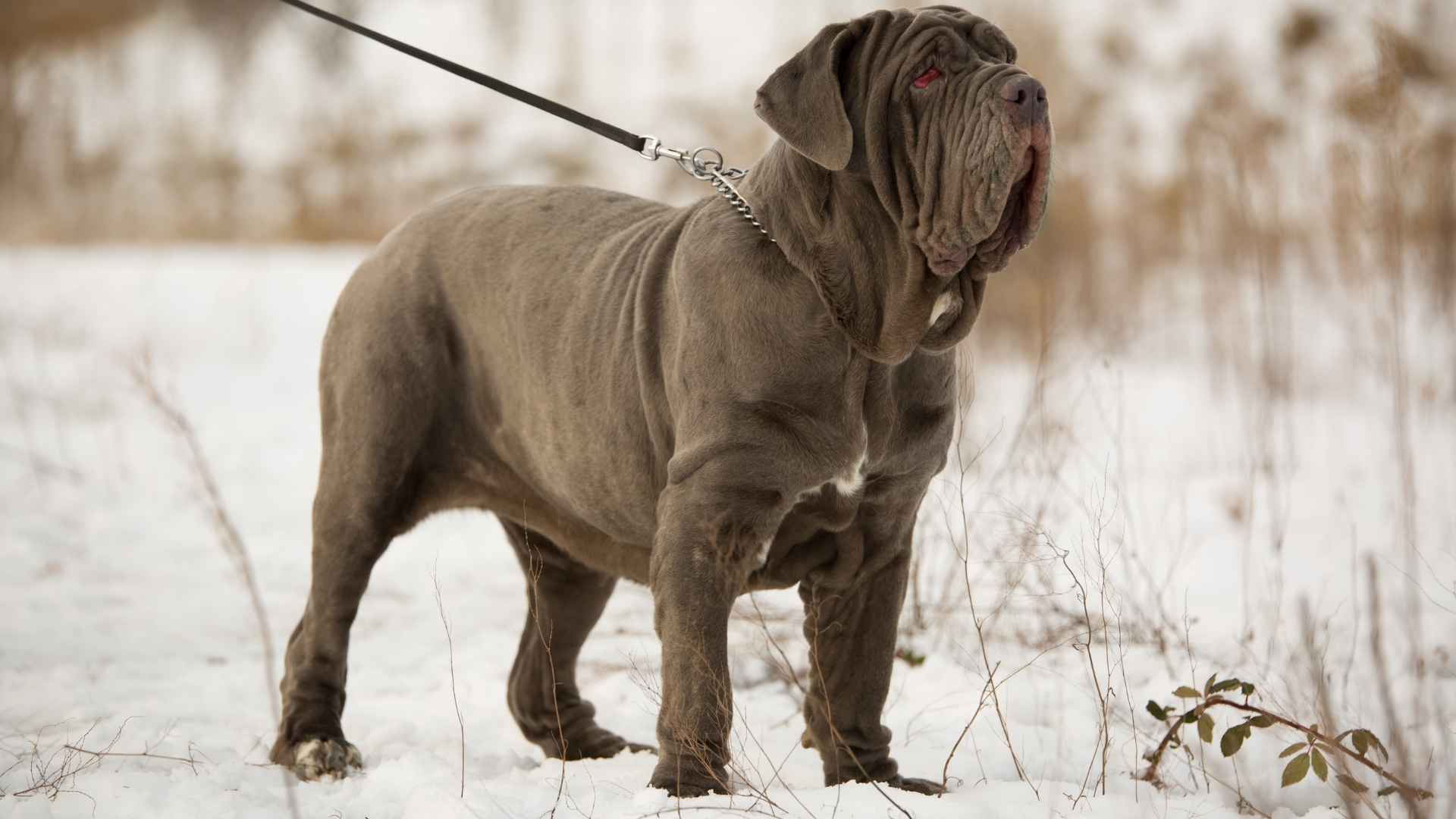When it comes to our beloved extra-large canine companions, understanding their lifespan is crucial for offering them the best care possible. The phrase “dog years” just doesn’t cut it anymore—research has shown that a dog’s average lifespan can vary widely depending on breed, size, and overall health.
XL dog breeds, while majestic and loyal, tend to have shorter lifespans compared to their smaller counterparts. In many cases, small dogs live longer than large dogs by several years. Scientists believe this could be linked to the rapid growth rate of large breeds, which may trigger age-related illnesses earlier in life, including an increased risk of cancer.
Interestingly, the oldest dog ever recorded was a medium-sized Australian Cattle Dog, showing that different dog breeds—regardless of size—can enjoy a long life when loved, nourished, and cared for.
So, if you’ve ever wondered, “How long do XL dogs live?”—this blog will help break it down for you. We’ll explore what affects the average lifespan of XL dog breeds and what you can do to help your gentle giant live a longer, healthier life.
Average Lifespan XL Dog Breeds
1. Newfoundland
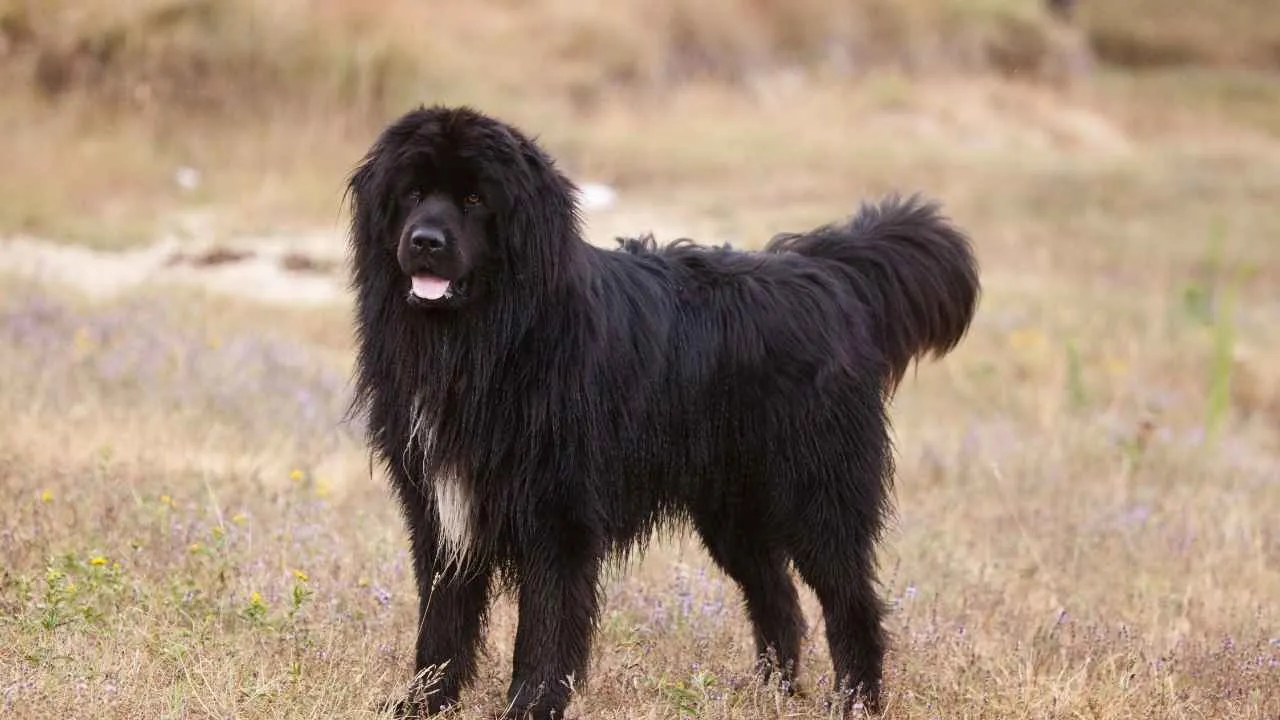
Affectionately known as “Newfies,” Newfoundland dogs were originally bred in Canada to assist fishermen by pulling nets and hauling gear. Their love for water and strong swimming ability make them natural-born rescuers. But beyond their impressive work ethic lies a sweet, patient companion often nicknamed the “nanny dog” for their gentle nature with children.
Newfoundlands are a large and powerful breed, with males reaching up to 150 pounds and 28 inches tall, while female dogs are slightly smaller. Despite their size, they’re known for being calm, affectionate, and exceptionally loyal. Their thick double coats keep them well-insulated, and their soulful expression often wins hearts at first glance.
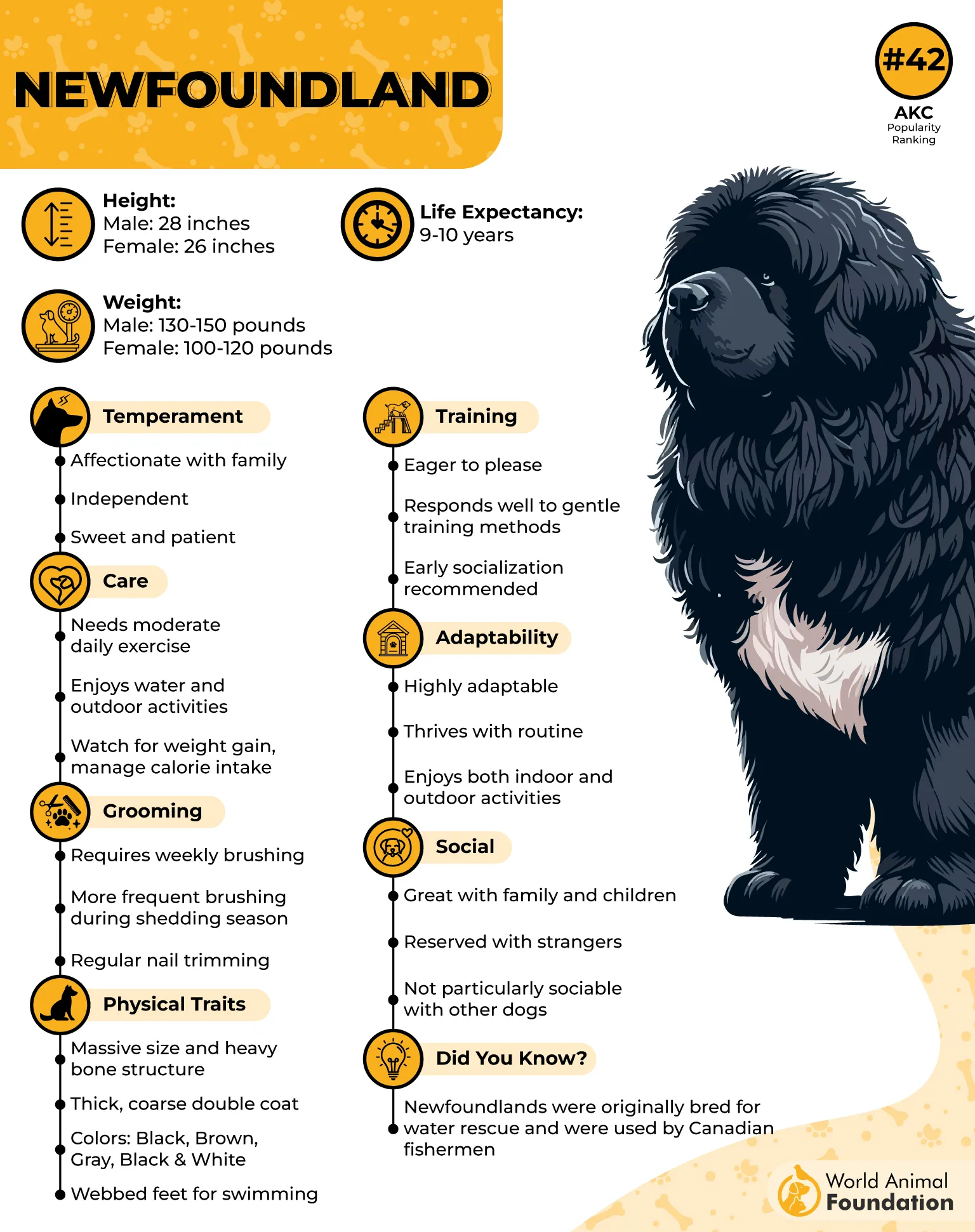
As noted by WebMD, these dogs thrive in loving homes and are famously good with both kids and other pets. While they’ll alert you to unfamiliar visitors, they quickly warm up when they sense no threat. Newfies are eager to please, quick to learn, and happiest when they’re included as part of the family.
With a moderate energy level, Newfoundlands benefit from regular walks, playtime, and occasional swimming. Once exercised, they’re content to curl up and relax. Overexertion and inactivity should both be avoided, as balance is key to keeping them healthy, especially due to their size.
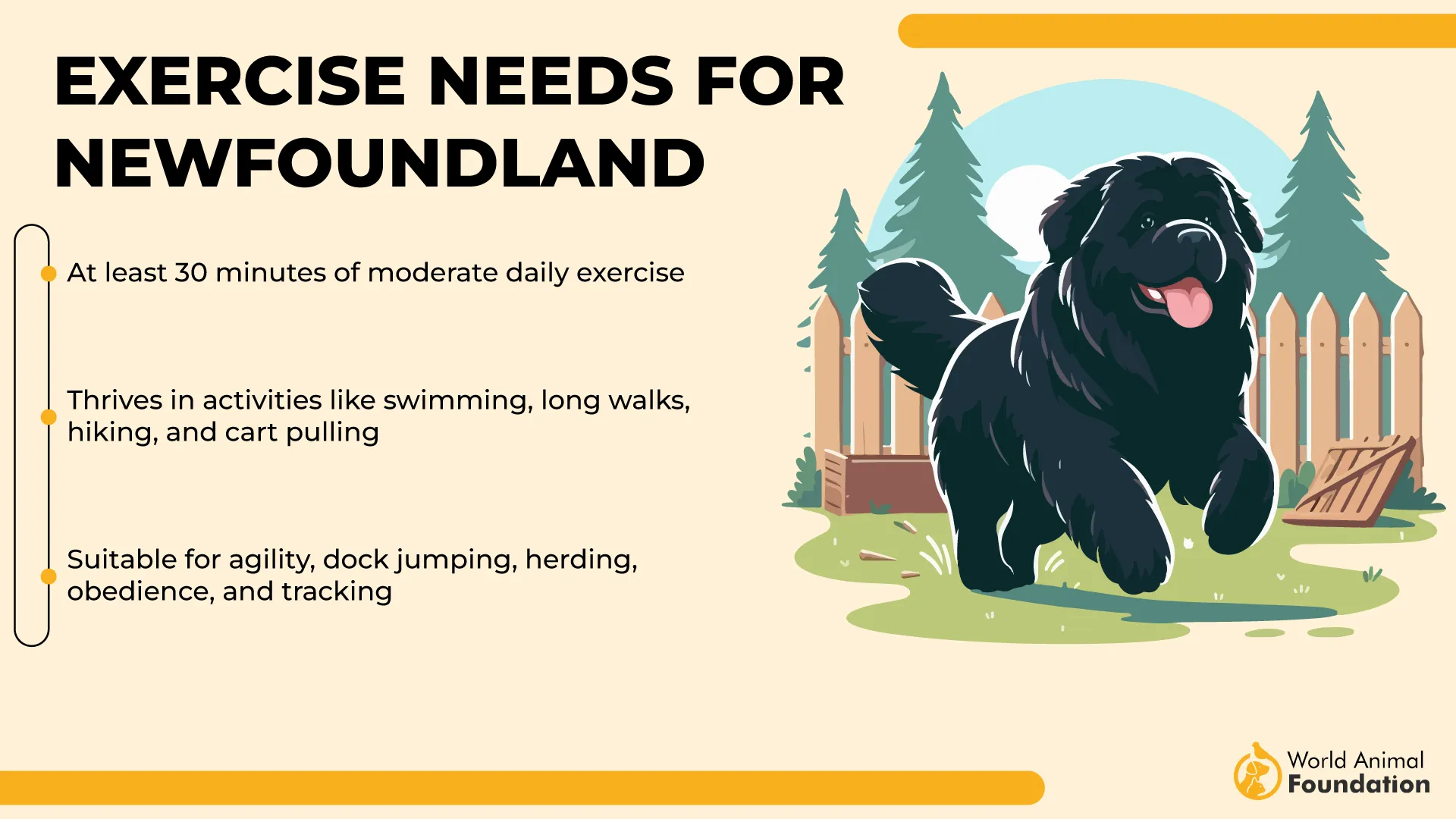
Newfoundlands typically live 8 to 10 years and, like many giant breeds, are prone to certain health issues. Common concerns include hip and elbow dysplasia, cystinuria (which causes urinary stones), and subvalvular aortic stenosis (SAS), a heart disease often seen early in life. Regular veterinary care can help with early detection and management.
Fun Fact:
True to their heritage, Newfies have a legendary instinct for water rescue. Their courage and strength have led them to save countless lives from drowning. One famous Newfie Seaman even accompanied the Lewis and Clark expedition, bravely protecting the crew from wildlife.
2. Dogue de Bordeaux
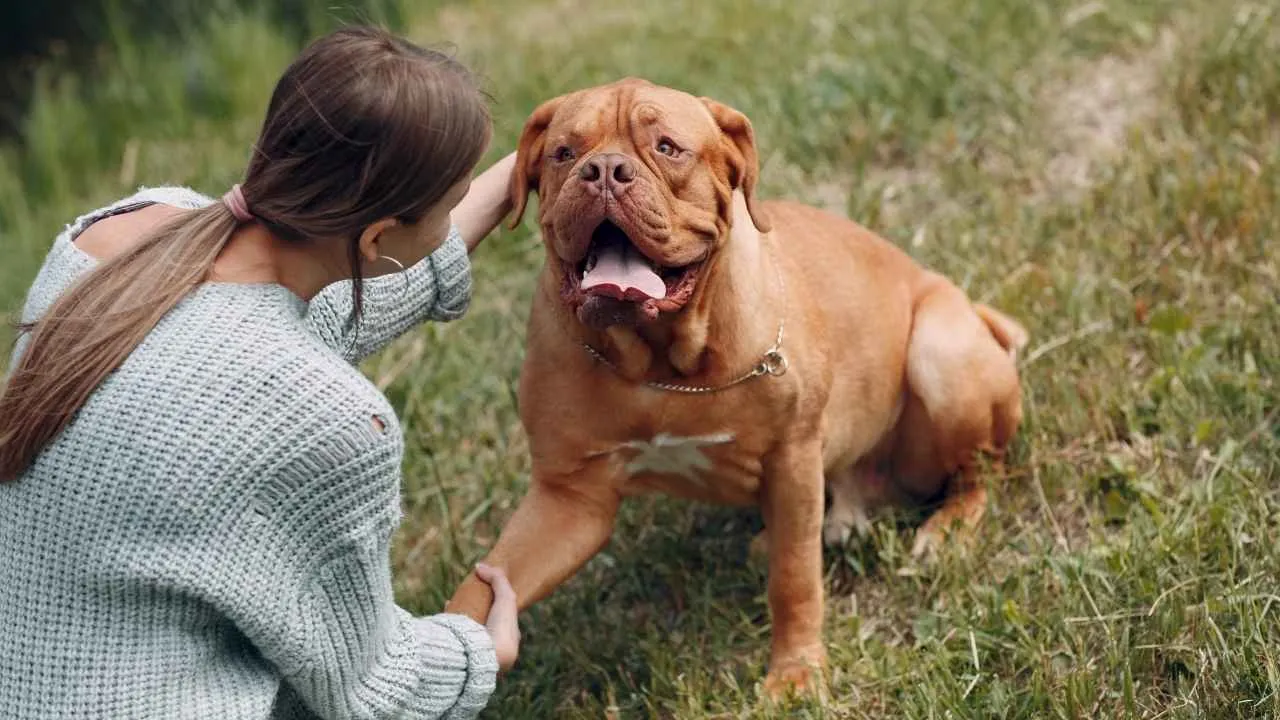
Also known as the French Mastiff or Bordeaux Mastiff, the Dogue de Bordeaux is a powerful breed with origins in 14th-century France. Originally bred to guard estates, protect livestock, and hunt large game, this muscular giant has long worked closely with humans. Beneath their imposing look lies a calm, loyal, and affectionate companion.
Males typically stand 24–27 inches tall, with females slightly shorter at 23–26 inches. Weighing between 99 and 145 pounds, they’re known for their massive heads, signature wrinkles, and serious expression. Despite their formidable appearance, they make loving and devoted family dogs.
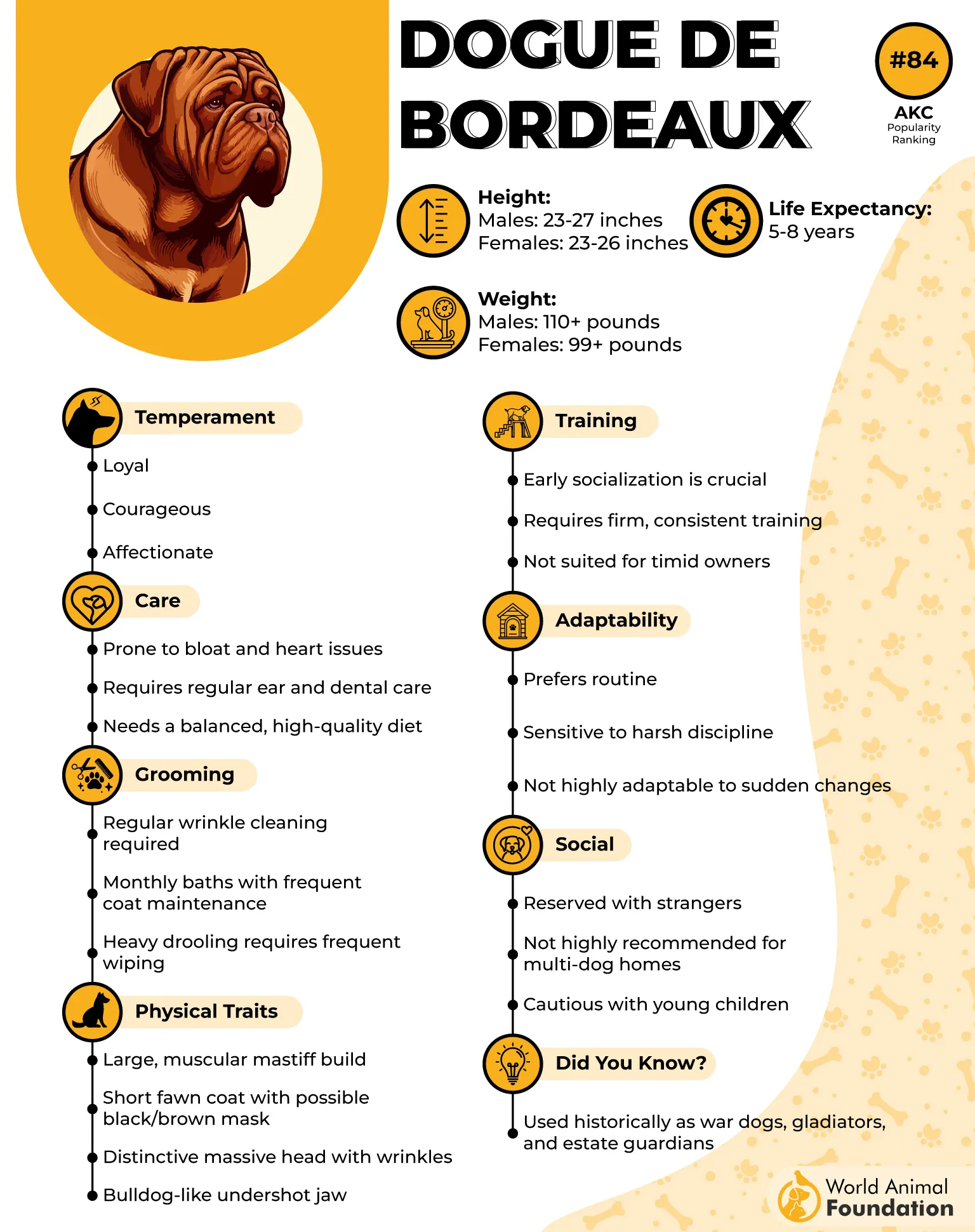
Naturally protective and even-tempered, this breed thrives with early socialization and firm, positive training. While affectionate, they can be strong-willed, so starting early helps shape a respectful, well-mannered adult.
Dogue de Bordeaux has a shorter lifespan and is prone to hereditary conditions. Choosing a reputable breeder helps reduce health risks. It’s also important to avoid overfeeding or overexercising young dogs to protect their developing joints.
As noted by AKC, common health concerns include treatable cancers like lymphoma, as well as more serious issues such as dilated cardiomyopathy and subaortic stenosis. Bloat, joint dysplasia, and footpad hyperkeratosis are also potential risks. Routine vet care and attention to their wrinkled skin can help catch and manage problems early.
3. Neapolitan Mastiff
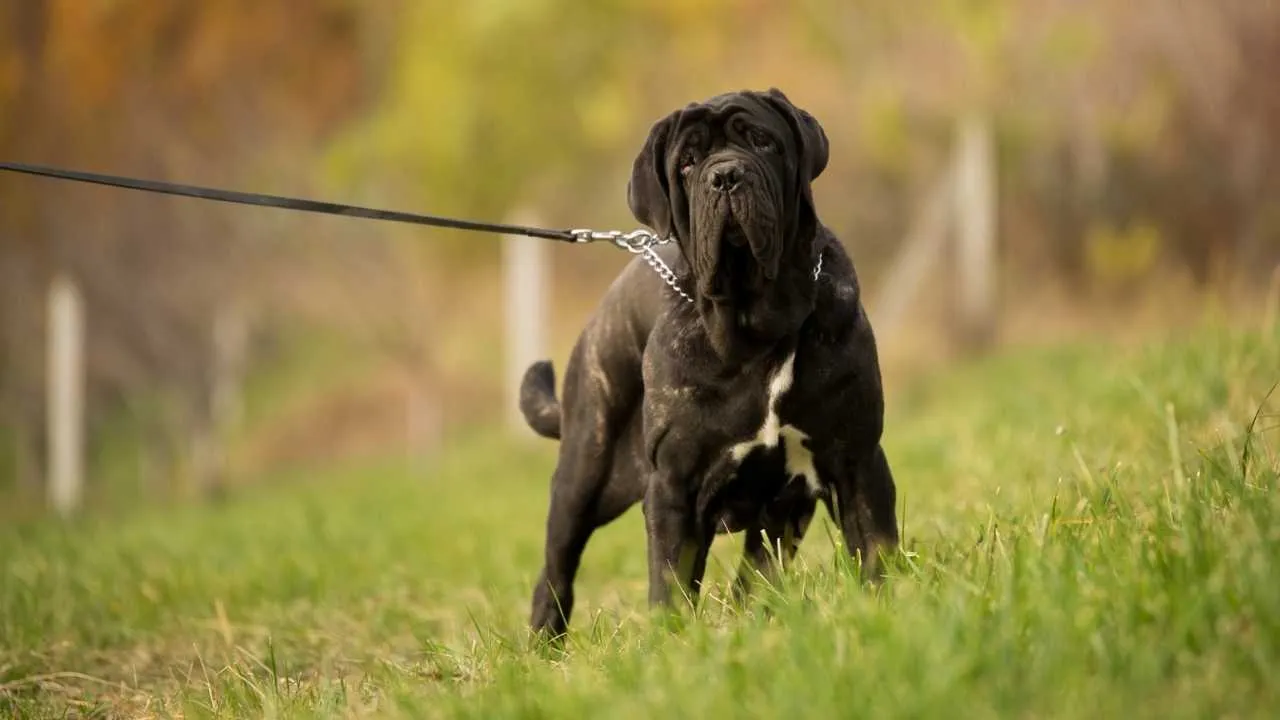
With a lumbering gait, droopy skin, and massive frame, the Neapolitan Mastiff is undeniably eye-catching. Known as the “Neo” or “mastino,” this ancient breed dates back to around 3000 BCE.
Originally used in warfare and later as estate guardians in Italy, today’s Neos are more likely to be found lounging at home. Despite their formidable appearance, they’re affectionate and deeply devoted to their families.
Their loose, wrinkled skin was intentionally bred to deter intruders, but beneath those heavy jowls is a steady and gentle dog. One even made it to Hollywood—Hagrid’s dog, Fang, in the Harry Potter films was portrayed by a Neapolitan Mastiff.
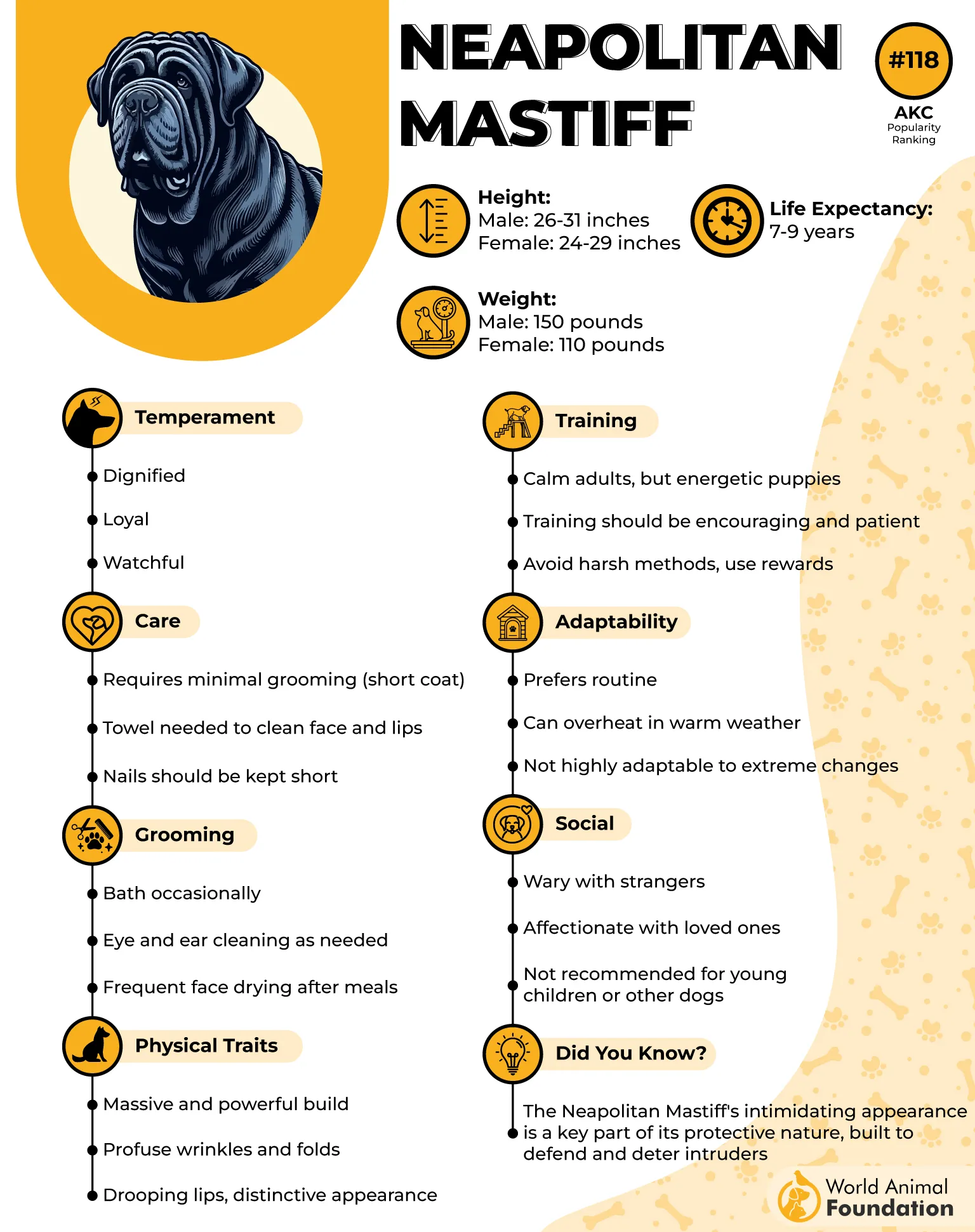
While they may look intimidating, Neapolitan Mastiffs are calm, loyal companions. They form strong bonds with their people and are generally quiet, only barking when necessary. Protective but not needlessly aggressive, they prefer staying close to their loved ones and observing the world from the sidelines.
Neapolitan Mastiffs are prone to hip and elbow dysplasia due to the strain their weight puts on joints, often leading to arthritis. Their deep chests make them vulnerable to gastric dilatation-volvulus (bloat), a potentially life-threatening condition.
Heart problems, such as dilated cardiomyopathy, are another concern. Cherry eye, demodectic mange, and excessive drooling are also common in this breed. Their expressive faces and heavy jowls mean you may find yourself wiping drool more than once a day. They’re also known for snoring, snorting, and even being a little gassy—but it’s all part of their charm.
4. Leonberger

With its lion-like mane and commanding presence, the Leonberger is a giant breed that blends strength with grace. Bred in Leonberg, Germany, it was designed to resemble the lions on the town’s coat of arms. The breed likely descends from a mix of Newfoundland, Saint Bernard, and Great Pyrenees, originally serving royalty before becoming a working dog on farms and later a loyal family companion.
Nearly lost during the World Wars, the Leonberger made a remarkable recovery and now excels as both a search-and-rescue dog and an affectionate pet. Despite their impressive size—up to 170 pounds and over two feet tall—they’re calm and patient, especially around children. Their friendly nature and even temperament make them well-suited to family life.
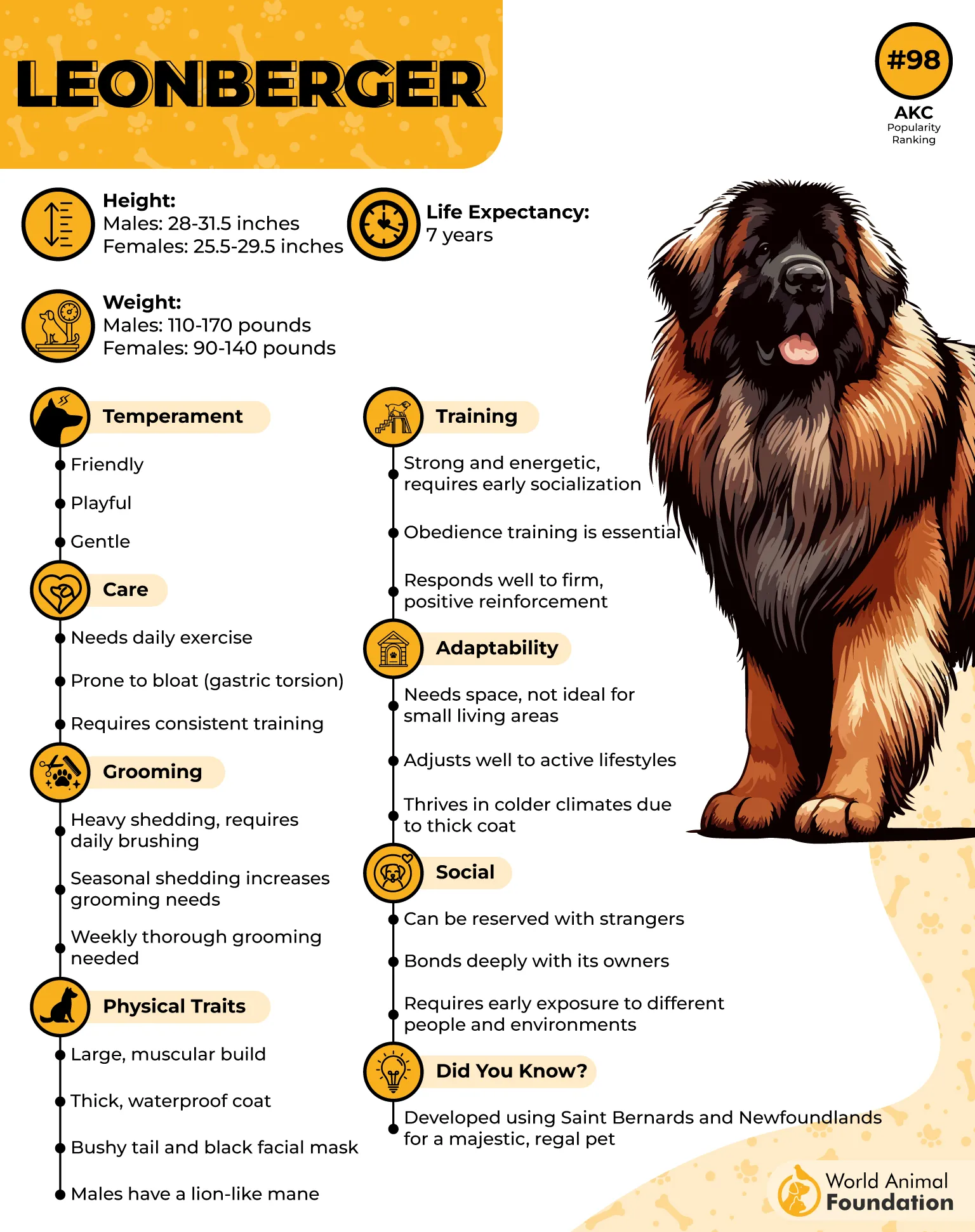
These dogs are affectionate, loyal, and intelligent, thriving when involved in daily routines. They’re generally calm indoors but enjoy staying active outside. As they mature, Leonbergers may become a bit reserved with strangers, so early socialization and consistent training are essential to keep them well-mannered and confident.
Like many large breeds, Leonbergers are at risk for certain health issues. PDSA states that bloat, a potentially fatal stomach condition, is a serious concern, and preventive surgery (gastropexy) is often recommended. They’re also prone to hip dysplasia, arthritis, and certain cancers, especially affecting bones and blood vessels.
Dilated cardiomyopathy—a disease affecting heart function—is another known risk. Healthy weight management, joint care, routine veterinary checkups, and preventive care can significantly improve the quality of life anda dog’s life expectancy.
5. Saint Bernard
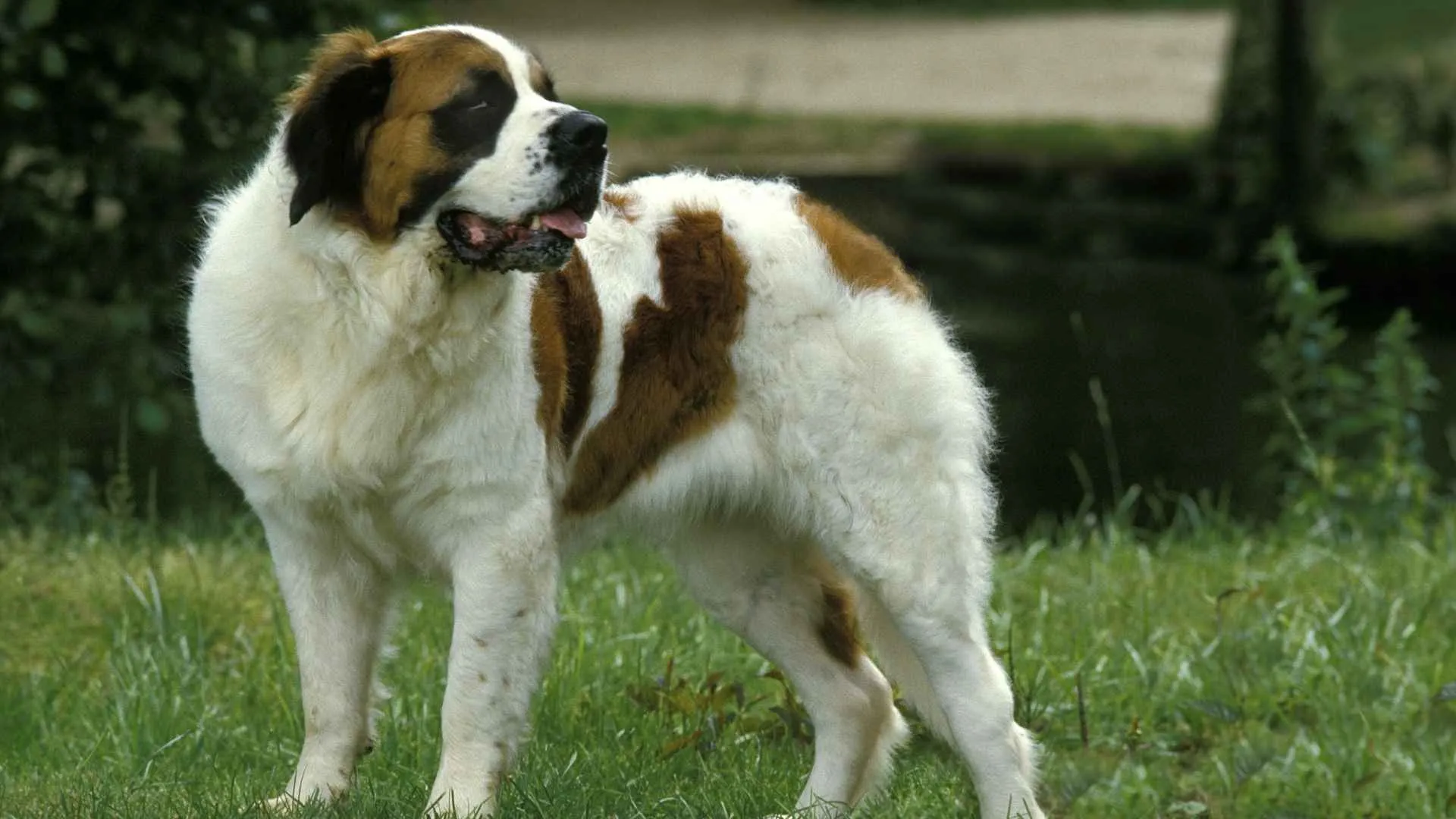
If there were a trophy for gentleness among giant breeds, the Saint Bernard would easily take the crown. Known for their calm nature and affectionate spirit, these lovable giants are wonderful family companions.
The breed’s history traces back to the 18th century when monks in the Swiss Alps bred them to assist lost travellers. By 1774, Saint Bernards were recognized for their search-and-rescue work, credited with saving over 2,000 lives in the mountains. Their courage and instinct earned them the nickname “Good Samaritan Dogs.”
Saint Bernards have two coat types: smooth and rough. Smooth coats lie flat, while rough coats are longer, especially around the neck and legs. Their rich brown and white coloring is often paired with black facial markings.
Interestingly, efforts to create a warmer coat by crossing them with Newfoundlands led to longer fur, but also more snow clinging to their coats, making rescue work harder.
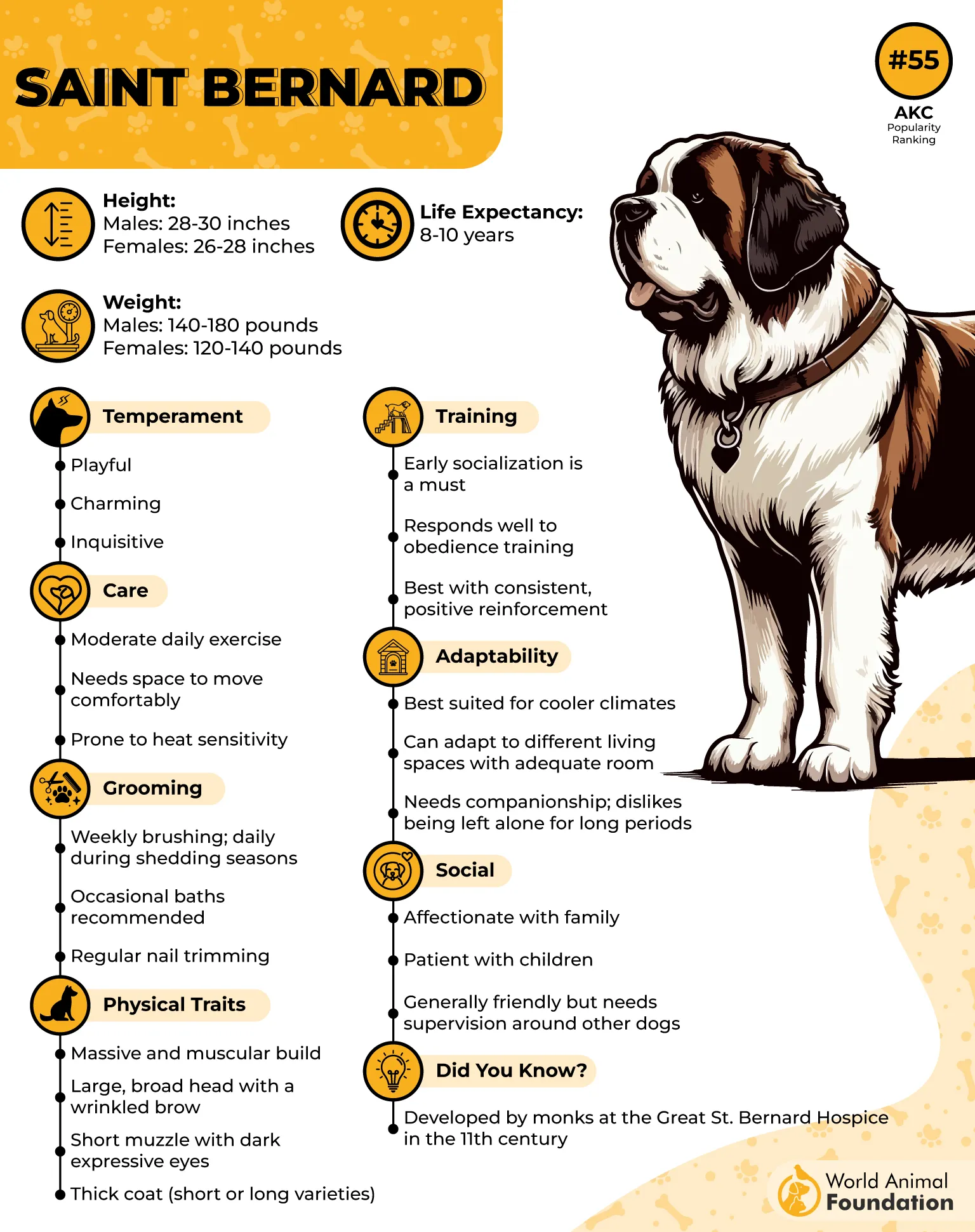
These dogs thrive in homes where they can stay close to their people. Despite their size, they’re incredibly gentle, friendly, and eager to please. They’ve transitioned from alpine rescuers to loving couch companions and are especially good with children, though their bulk means interactions with little ones should be supervised.
Though warm-hearted, their lifespan is relatively short, around 8 to 10 years. Like many large dog breeds, they’re prone to bloat, a life-threatening condition that sometimes requires preventative surgery.
Other health concerns include eyelid issues and osteosarcoma. To support their bone health, puppies should be fed high-quality dog food formulated for large breeds that encourages slow, steady growth.
6. Bullmastiff

Originally bred in 19th-century England, the Bullmastiff earned its place as a reliable estate guardian. Gamekeepers developed the breed by crossing English Mastiffs with Old English Bulldogs to create a dog strong enough to track and apprehend poachers without causing serious harm. Eventually recognized as a purebred, the Bullmastiff became known for its loyalty, imposing build, and calm vigilance.
Large and muscular, Bullmastiffs have a commanding presence. Male dogs typically reach 25–27 inches in height and weigh between 110 and 130 pounds, while females range from 24–26 inches and weigh 100–120 pounds.
Their short coat comes in red, fawn, or brindle, sheds moderately, and requires only occasional brushing. With a broad head, dark eyes, and deep-set muzzle, they carry a serious yet soulful expression, complemented by high-set, V-shaped ears.
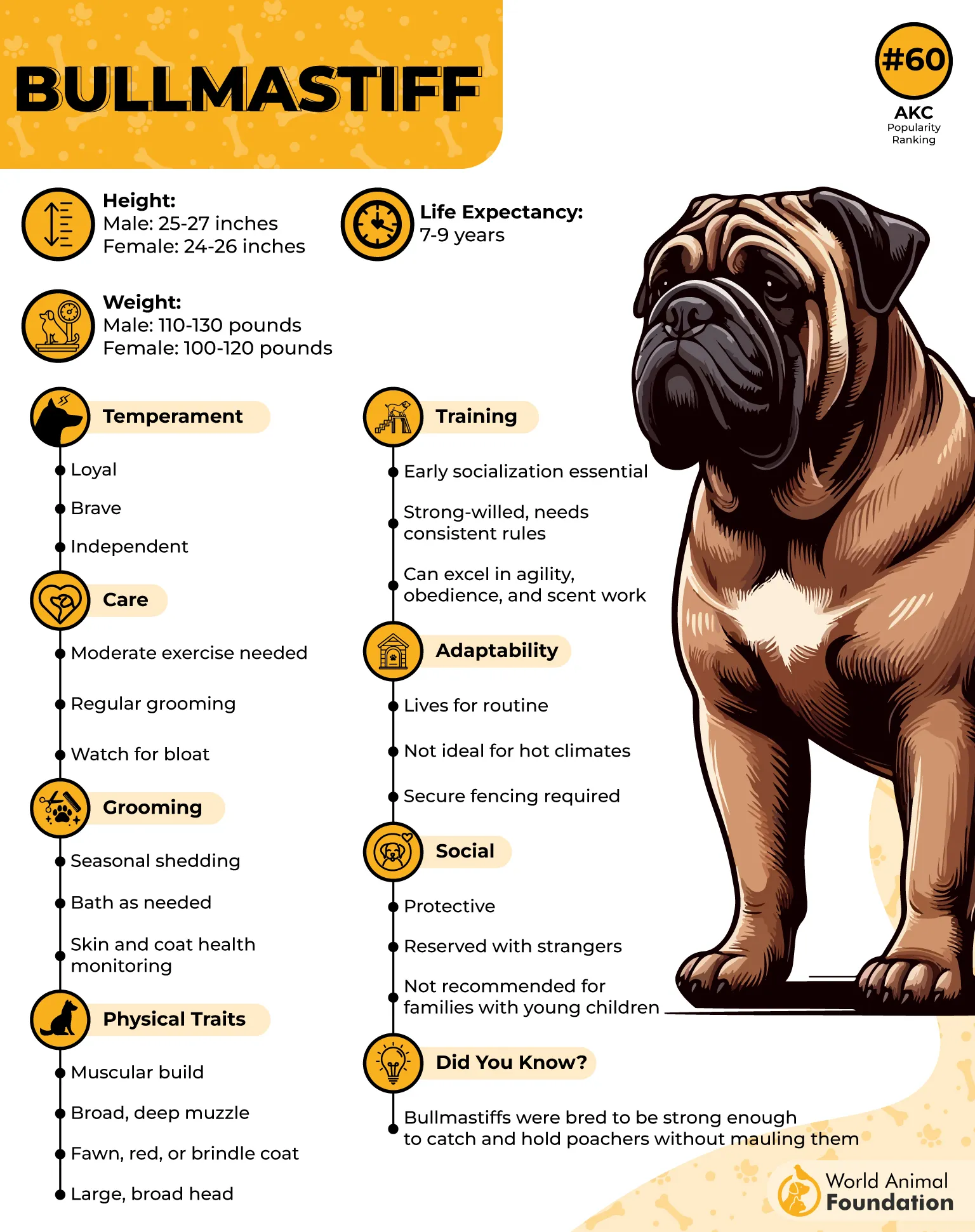
Affectionate and loyal, Bullmastiffs form strong bonds with their families but remain naturally protective. They can be wary of strangers, so early socialization is vital. Confident and occasionally stubborn, they do best with experienced pet owners who offer firm yet positive guidance. Despite their size, they love being close to their humans and will often try to be lap dogs.
Their average life span is around 7 to 9 years, and like many large breeds, they’re prone to certain health concerns. Dilated cardiomyopathy (DCM) can weaken the heart’s ability to pump blood, sometimes causing fatigue, coughing, or collapse. Other risks include subaortic stenosis (SAS), entropion (inward-rolling eyelids), and joint issues.
Responsible breeding practices helps reduce health risks. Compared to mixed breed dogs, some purebred dogs may be more prone to hereditary issues, though proper care and early attention to common signs of aging can improve their quality of life.
Pet parents should be aware of serious health concerns in Bullmastiff that include Bloat and cancer. Proper nutrition, routine checkups, and a supportive home environment all contribute to a healthier, happier life for this loyal companion.
7. Irish wolfhound
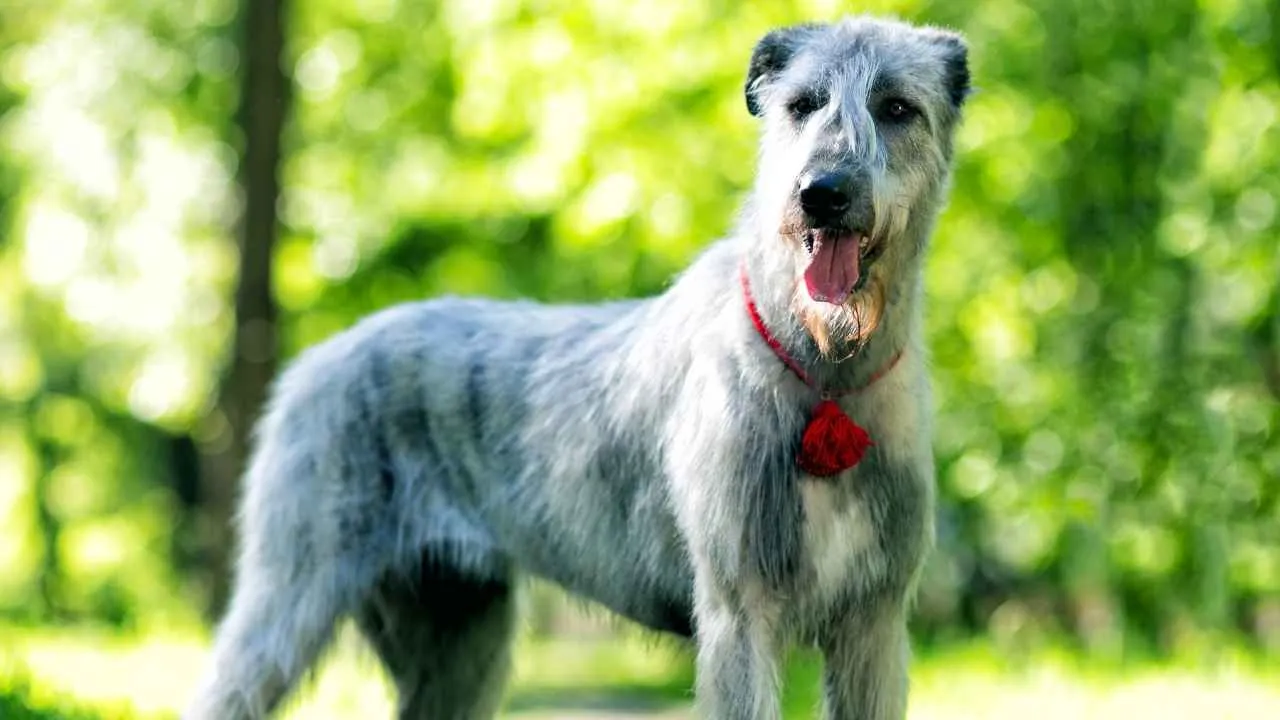
The Irish Wolfhound is among the tallest dog breeds in the world, often standing up to seven feet tall on their hind legs. Despite their imposing size, they’re calm, friendly, and make devoted companions.
Originally bred in Ireland to hunt big game, these dogs are now cherished family pets, best suited for homes with plenty of space. Their wiry, medium-length coat and lean, muscular frame lend them a rugged yet regal appearance.
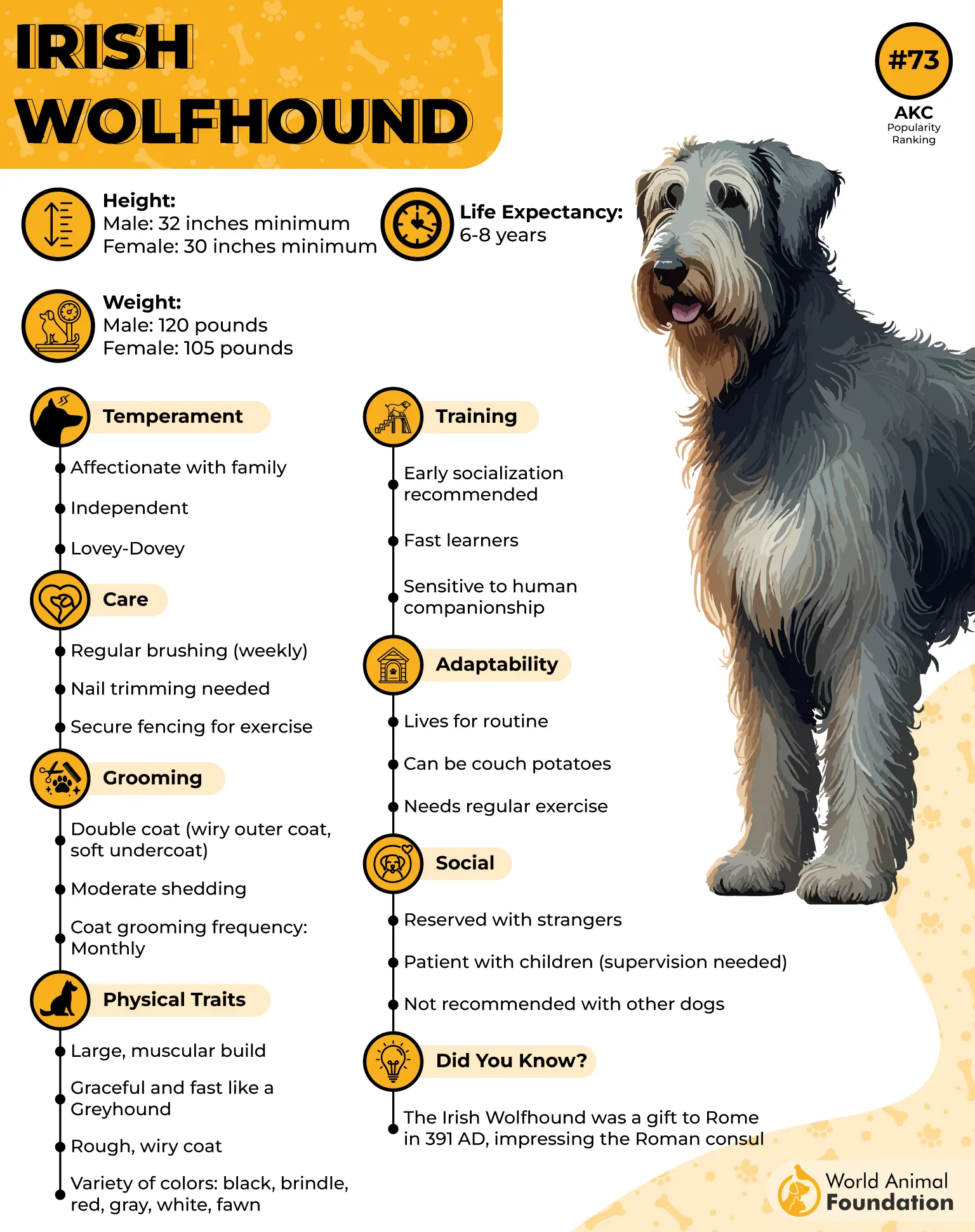
Gentle and affectionate Irish Wolfhounds are known for their quiet, easygoing temperament. They typically get along well with children and other pets, especially when socialized early. Though large, they’re not hyperactive, making them well-suited for families who want a relaxed, loyal dog.
Like many giant dog breed, they have an average life expectancy of 6 to 8 years—and are prone to certain health concerns. Bloat is a serious and potentially fatal condition that requires urgent attention and preventive care. Heart issues, including cardiomyopathy and atrial fibrillation, are also common diseases and should be monitored with regular veterinary visits.
Other health risks include osteosarcoma (bone cancer), liver shunts, pneumonia, and joint problems such as hip and elbow dysplasia. Eye conditions like cataracts and progressive retinal atrophy can also affect their quality of life. Staying informed and proactive with health care is essential for this breed.
While they retain a strong prey drive, Irish Wolfhounds tend to be mellow indoors. A securely fenced yard is important to keep them safe, and regular exercise, such as long walks or lure coursing, helps keep them fit. Once matured, they adapt well to a more relaxed routine but still benefit from consistent physical and mental activity.
Conclusion
When considering the average lifespan of XL dog breeds, it’s important to recognise that large and giant breed dogs generally have shorter lifespans compared to medium-sized dog breeds and smaller dog breeds. While smaller breeds like Jack Russells often enjoy longer lives, many large breeds such as Great Danes, Anatolian Shepherds, and German Shepherds tend to live fewer years.
Factors like a dog’s physical and mental health, proper nutrition, including supplements like fish oil, and attentive dog ownership can positively impact a dog’s lifespan and overall well-being. Senior dogs, regardless of breed, benefit from care that supports both mental health and physical wellness.
Understanding the typical lifespan differences among different breeds—from pure breeds like Golden Retrievers and Border Collies to mixed breeds—helps owners prepare for their pet’s needs. While some dog breeds live longer than others, all require time for rest, exercise, and social interaction with other dogs and animals to thrive throughout their lives.


